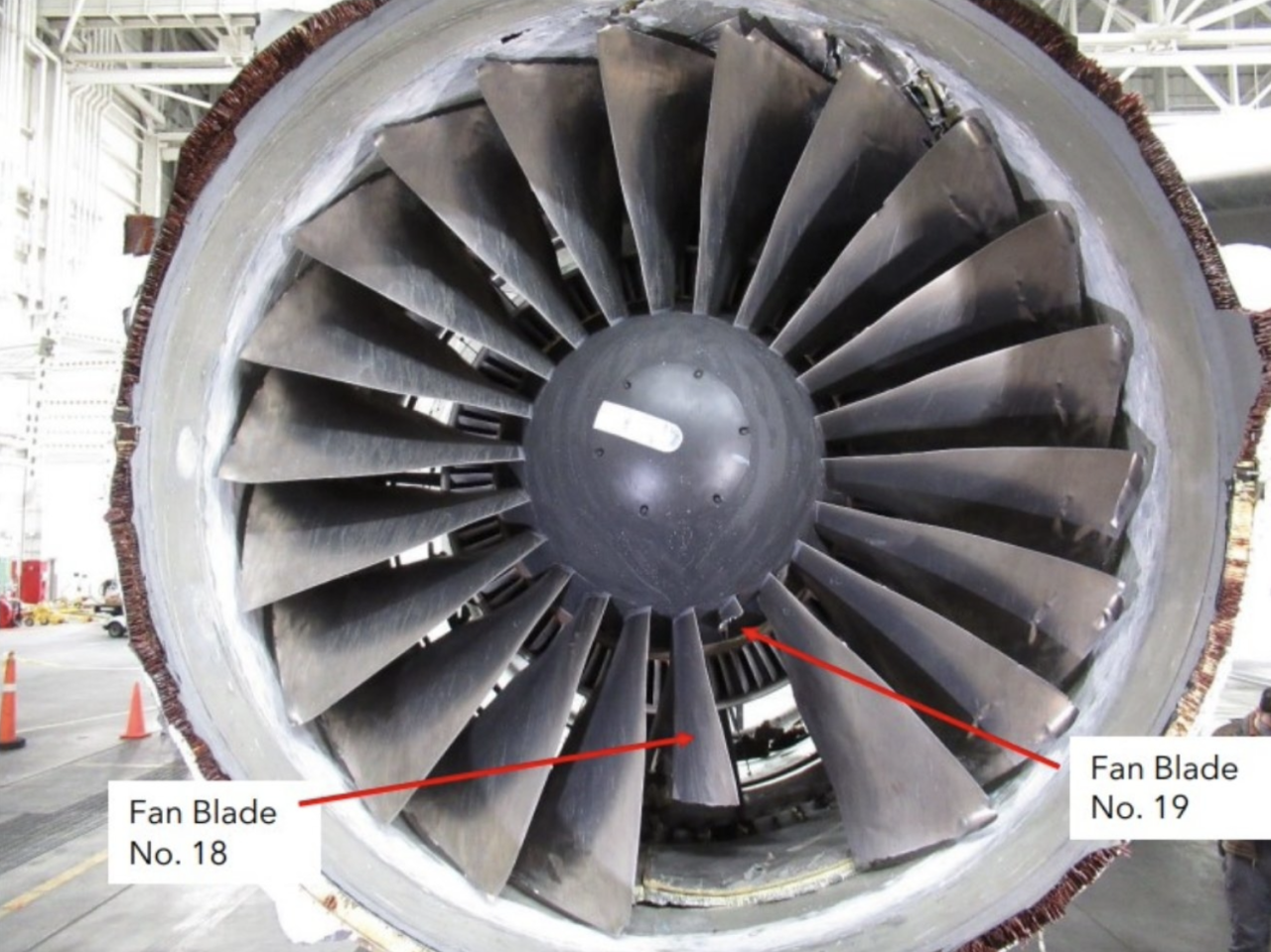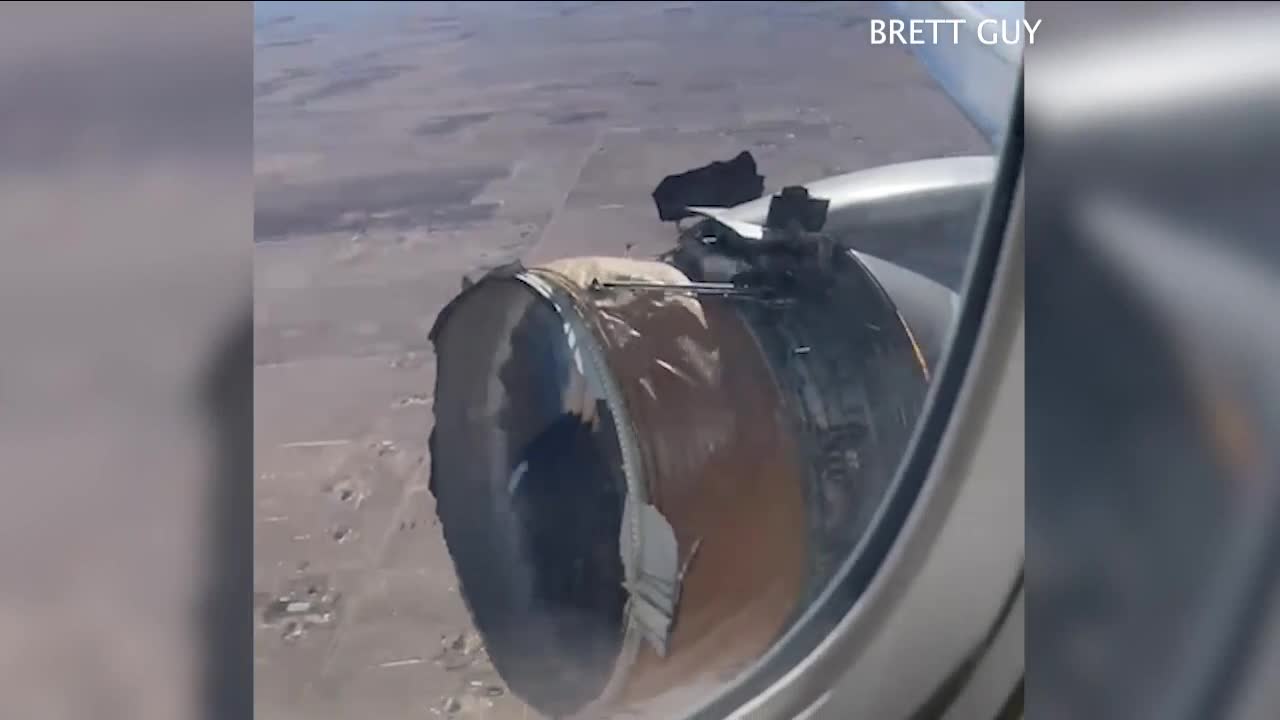DENVER — Thirty months after a United Airlines flight out of Denver suffered an engine failure, raining debris down over Broomfield neighborhoods, the National Transportation Safety Board on Friday released its final report, outlining what caused the right engine fan blade to malfunction and recommended safety and design changes following the Feb. 21, 2021 incident.
The final report into United Airlines Flight 328’s emergency over Colorado also found "inadequate inspection of the blades," which had previously found "low-level indications of cracking" during an overhaul inspection of the fan blade five years before the incident flight.
UA Flight 328, a twin-engine Boeing 777 which had just departed from the Denver International Airport for Honolulu, suffered a blade separation on the right engine, triggering multiple failures resulting in an engine fire while the aircraft was passing through 12,500 feet just five minutes after takeoff.
None of the 239 passengers or crew were injured, but a vehicle and home were damaged when part of the engine’s inlet lip skin and fan cowl support beam fell to the ground, according to the NTSB. No one on the ground was injured.
In its findings, the NTSB said the engine’s fan case contained the separated fan blade, as it is designed to do, but the explosive impact “resulted in a deflection of the fan case and contact with the nacelle doors and hinges, which subsequently resulted in the failure of the inlet aft bulkhead and the fan cowl support beam,” the report revealed. “The failure of the bulkhead, along with the damage to the inner and outer barrels, allowed these structures, as well as the inlet lip skin, to separate from the engine.”
Under federal aircraft certification standards, inlet and fan cowl separation due to a “fan belt out (FBO) event is prohibited which led Boeing to implement ‘modifications to the inlet to ensure that inlets and fan cowls remain in place during an FBO event that may damage the aft bulkhead, inner barrel, or outer barrel and modifications to add strength and ductility to the inlet by incorporating additional metallic structure,’" the report said.
Updated inspection procedures were developed to adequately ensure fan cowls are inspected for moisture damage, which the FAA said can happen over time, degrading the cowl strength.
Those inspection procedures were mandated in the summer of 2022 and additional modifications are expected, according to the report.
The February 2021 failure over Colorado was the fourth time an FBO event has happened for certain Boeing 777 aircraft equipped with Pratt and Whitney 4000 engines, with the Denver incident labeled the one producing the most damage.
Responding to the emergency over the Denver metro skies, the NTSB report noted the UA 328 flight crew followed the emergency checklist procedures, including activating the engine’s dual fire extinguishers. But as video shared by passengers noted, the flames continued during the flight. This was due to the extent of the engine damage caused by the fan blade out event.

The NTSB report outlined a chain of events that resulted in the engine fire, including damage that began with the initial loss of the fan blade, which generated more energy rubbing against the case and "created rotating torsion loads through the engine core structure; and the continued fan shaft imbalance during the engine run-down, which created rotating bending loads through the core structure,” it stated.
The fire was further fed by small quantities of hydraulic fluid leaking into the engine area fueling the fire, the NTSB revealed. When the pilots activated the engine fire handle, an engine-driven hydraulic pump shutoff valve should have closed, but the investigation found it failed as a result of “silicone lubricant contamination of electrical contact components in the valve’s DC motor,” the final report stated.
In identifying further causes behind the fire, the report also pointed to the failure of flange bolts which attach the main gearbox to the engine. Flange bolts attached to the engine that did not initially fail eventually failed, resulting "in the total separation of the 'K' flange, which allowed hot, compressed gases to escape the engine core and provided an ignition source in the engine nacelle,” the report said.
Following the United Airlines Flight 328 incident, engine maker Pratt & Whitney is expected to make improvements to strengthen the flanges with components available sometime in 2025.
The fan blade inspections
In 2016, during a United Airlines inspection of the same fan blade, thermal acoustic imaging (TAI) found “multiple low-level indications, two of which were in the fatigue crack origin area,” the NTSB found.
During that inspection, it was concluded what was indicated on the TAI was camera noise or loose contamination in the cavity of the fan blade.
The report said the fan blade failure during the February 2021 United Airlines flight was a result of a fatigue crack that began “at the surface of an internal radius in a hollow cavity within the blade,”
Then, in 2018, after a separate fan blade failure in the same model of Pratt & Whitney Engine, UA reviewed the 2016 data from the incident blade and again determined that “the indications were not identified as anomalous.” The NTSB report noted the fan blade failed during the February 2021 flight due to a fatigue crack that grew over the years.

Further citing probable cause, the NTSB pointed to Pratt & Whitney, the engine manufacturer’s recommended schedule of blade inspections by TAI which was increased in April 2022 from the 6,500 to 1,000 cycles.
Additionally, fan blades are inspected by ultrasonic testing every 275 cycles.
Contributing to the engine damage was a failure in the engine inlet design, which should have contained the fan blade as it broke, according to the NTSB report. That “failed to ensure that the inlet could adequately dissipate the energy of, and therefore limit further damage from, an in-flight fan blade out event.”
The NTSB finally pointed to the failure of the engine’s flange that allowed flammable fluids to fuel the fire that "could not be extinguished," the report stated.










